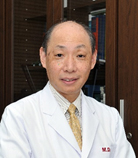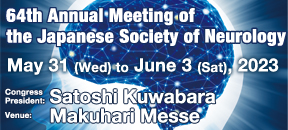- home > Greeting from the executive President
Greeting from the executive President
Inaugural Address by President of the Japanese Society of Neurology
Kazutoshi Nishiyama, MD, PhD
President/CEO of the Japanese Society of Neurology
Professor and Chair, Department of Neurology, Kitasato University School of Medicine

It is a great honor and privilege to be appointed President of the Japanese Society of Neurology, upon succeeding Past President Tatsushi Toda who completed his term of office at the end of the 63rd Annual Meeting of the Japanese Society of Neurology held in Tokyo in May 2022. On the occasion of the start of the new Board of Directors, I would like to greet all the members of the Society with this short remark.
Looking back at the history of the Japanese Society of Neurology, the Society was inaugurated in 1960 at the first general assembly of the “Japanese Society of Clinical Neurology”, and the name of the Society was changed to “Japanese Society of Neurology” in 1963, which has continued until to date. However, the root of neurology in Japan may be traced back to the first “Japanese Society of Neurology” founded in 1902. In other words, neurology in Japan has a long history of 120 years, and the Japanese Society of Neurology has played a key role in the rapid advances in modern neurology. Moreover, the Japanese Society of Neurology is a large society with a membership of more than 9,000. I am truly honored and humbled to be appointed to represent such a large organization with rich history and tradition. Indeed, when I revisit the history of the foundation and development of the Society and see the names of our prominent mentors and seniors, I feel determined to do my utmost to take on the daunting responsibilities.
Under the leadership of Professor Tatsushi Toda, Professor Ryosuke Takahashi, Professor Hidehiro Mizusawa, and other past presidents and directors, the Japanese Society of Neurology, which has become a general incorporated association, succeeded to accelerate the history of development of the Society. Institutionally, a new system by which representatives, directors, and President of the Society are elected through a democratic process is already in place. Upon assuming the position of President, I will learn from the development history of the Society and will continue to strive for further accomplishment in fields that have attained outstanding success, without losing speed. On the other hand, public recognition of the Society remains low; there are still many regions where we are not able to provide sufficient medical care in the field of neurology. In other words, there are mounting challenges that the Japanese Society of Neurology must address in order to meet the people’s expectations. In addition, neurologists in Japan are also expecting the Society to take measures to solve numerous issues such as response to the new board certification system, management of the Society in the COVID-19 pandemic, and elimination of regional disparities. I would like to address these issues with speed. Here, I would like to share my thoughts on the operation policy of the Society for the term in the next two years.
Academic advancement, research support for overcoming neurological diseases, and further promotion of internationalization
There are still many neurological disorders for which no effective treatments are available. The Japanese Society of Neurology has been actively supporting challenging research seeds with a view to develop future treatments for these incurable diseases. In addition, we will continue to strengthen training for young neurologists who will be leaders of such translational research. These investments may not bear fruit immediately, but we hope that in the long run they will be the cornerstone of overcoming neurological disorders in Japan.
The predecessors of the Japanese Society of Neurology worked unceasingly day and night aiming to establish a position of the Society that is respected not only in Japan but also in the world. I would like to further promote internationalization with the goal to be at the same level as other international academic societies such as the American Academy of Neurology and the European Academy of Neurology. To this end, I will continue to put efforts in various approaches such as enhancing the website of the Society, promoting recruitment of overseas members, planning academic meetings that can be enjoyed by overseas participants, and enhancing the official English journal of the Society, "Neurology and Clinical Neuroscience".
"The Japanese Society of Neurology recognized by the public" / society operations meeting peoples' expectations
With a large membership of neurologists, the Japanese Society of Neurology has been devoting wholeheartedly to the health and welfare of the people. However, due to its relatively short history, it is not yet well known to the public or the society. Many neurologists are engaged in the clinical care and research of “common diseases” in the field of neurology; diseases suffered by many people, such as stroke, dementia, headache, and epilepsy. However, there are still some regions and fields in which we have not been able to provide sufficient medical care to satisfy the needs of the people, and this is an issue that the Society should urgently tackle.
The Japanese Society of Neurology does not exist on its own, and the greatest significance of its existence is to meet the mandate of the people. Therefore, during this term of the Board of Directors, I would like to consider society operations with the motto: “the Japanese Society of Neurology recognized by the public”. To that end, I would like to develop strategies to make the Japanese Society of Neurology, which is not yet well recognized now, widely known to the public. While we further develop the works on intractable neurological diseases, which are the expertise of the Japanese Society of Neurology, we will also earnestly tackle the common diseases that are making a large number of people suffer. I would like to do my very best to implement society operations that meet the expectations of the people through making the above contributions.
"The Japanese Society of Neurology for everybody" / society operations that value diversity
Neurologists have many different ways of working, and there exists an extremely wide diversity. To give some examples of the diverse practices of neurologists, there are specialists who specialize in neurological diseases, general practitioners who are also trained in neurology, home care doctors who provide care for intractable neurological diseases, medical researchers who research with the goal to overcome neurological diseases for which there is yet no cure, doctors who specialize in acute care for stroke, physicians who treat common diseases such as headache and dementia in clinics, doctors who work in neurological ICU, neurologists who work in business or government, and many others. These are all established career paths for neurologists. Such diversity can lead to division and exclusion, depending on the operation policy of the Society. However, I consider this diversity to be one of the greatest characteristics of the Society. Therefore, during this term of the Board of Directors, I plan to foster an attitude among neurologists to respect each other's diversity by setting the theme “the Japanese Society of Neurology for everybody”, and implement society operations so that all neurologists can come to love the Japanese Society of Neurology.
Training of neurologists who will lead the next generation
As of March 2022, the Japanese Society of Neurology had 9,560 full members. In some of the recent years, we saw an increase of more than 400 new members in one year, and the number of members has increased by about 1,000 in the last five years. While these figures reflect the results of public relations activities and recruitment activities promoted by the Society, at the same time, they may also signify the great expectation of the people to the Society. However, the current number of neurologists is by no means sufficient to meet the societal needs. We need more young doctors to choose the career path of a neurologist. For that reason, it is also important to prepare a social environment so that they can feel secure to choose the career path of a neurologist. It is necessary to publicize widely that there is not only one career path for neurologists and that the Society encourages diverse career paths. And I am keenly aware of the necessity for measures to protect the livelihood and career path of these diverse neurologists. During this term of the Board of Directors, we will consider a proposal of establishing a new organization for neurology clinicians.
At this juncture of the start of the two-year term, having acquired a deep understanding of the above-mentioned tasks, I will devote myself wholeheartedly to the development of our Society, and will greatly appreciate your guidance and encouragement.







